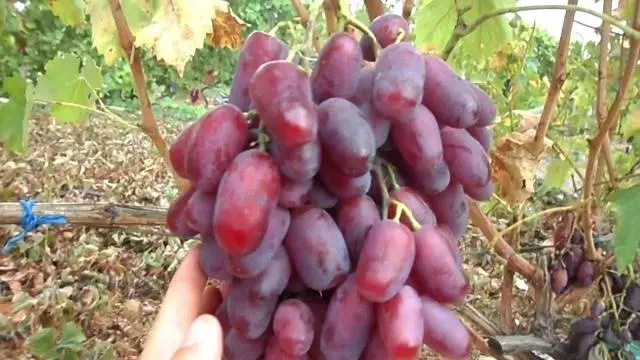Contents
Many beginners in viticulture, trying to understand the variety of varieties and modern hybrid forms of grapes, make the mistake of believing that old varieties no longer make sense to grow, as they have been replaced by new, more resistant and easier to handle. Of course, in many ways, breeding has indeed made a huge step forward, and for many vegetable and fruit crops, old varieties are often incomparable with new ones obtained in recent decades.
But grapes have always been grown by true enthusiasts, for whom caring for their plant pets was even more than an ordinary hobby. It is not in vain that the maximum number of well-known and now popular hybrid forms of grapes were obtained from the environment of amateur winegrowers, pleasing with their characteristics of yield, taste and stability.
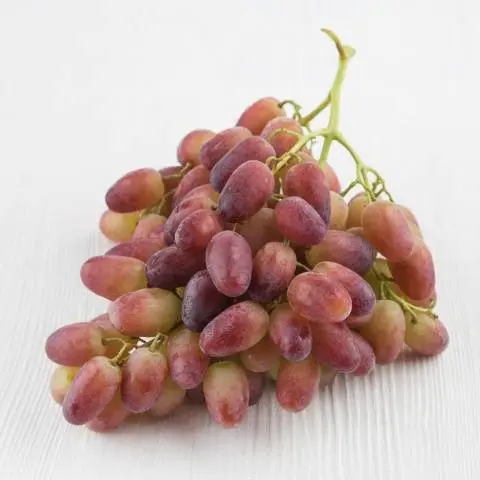
Therefore, it is not surprising that the Rizamat grape, bred more than half a century ago in Central Asia, still remains unsurpassed in some of its characteristics, and above all, in taste and yield. Yes, it takes a lot of effort to grow it, but the result is worth it and real growers understand this well. It is for this reason that the Rizamat grape is still grown in many areas, and perhaps even those who once removed it still regret it. You can find a description of the variety and a photo of the incomparable Rizamat in this article, but its seedlings will be much more difficult to find. Moreover, in recent years a large number of varieties have appeared, which, hiding behind his name, are trying to find their buyer. But almost all of them are practically incomparable with the true Rizamat grape variety.
Variety description
The Rizamat grape variety is unique in that it is equally excellent both when consumed fresh and when dried as raisins. Therefore, this variety is often called not just table, but even table-raisin. Rizamat grapes were obtained in the middle of the last century in Uzbekistan by the famous wine grower Rizamat Musamukhamedov, after whom he received his name. The parents of this variety were the local grape varieties Katta-Kurgan and Parkent. But their offspring surpassed both parents in their characteristics.
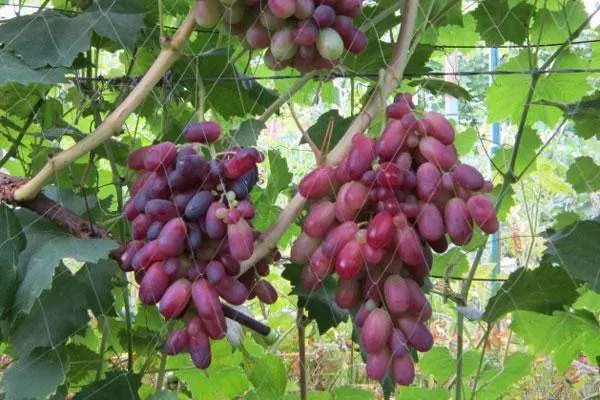
The growth form of Rizamat bushes is so significant that this variety is not even recommended to be planted in the general row. At least, when planting, it is necessary to retreat from the nearest grape bush 5-6 meters. It is best to give him complete freedom in growth and plant alone, especially since his flowers are bisexual, which means that there are no problems with pollination and the presence of other grape varieties nearby is not at all necessary.
At the same time, the leaves do not differ in particularly large sizes, they are round, slightly dissected, glabrous on the underside and have about five lobes.
Stepchildren grow throughout the season and very intensively, so they must be removed regularly, but pruning the bushes, especially in the spring and summer, is not recommended. Already at the end of summer, when the crop ripens, a small chasing of shoots is allowed. The shoots of this variety are distinguished by good ripening, and their small pruning will allow them to ripen along the entire length.
Pollination and tying of brushes in Rizamat are at a good level.
In terms of ripening, Rizomat grapes belong to medium-early varieties. For full maturation, it needs 130-150 days from the beginning of the growing season, and the sum of active temperatures must be at least 3000 °. Usually Rizamat begins to ripen in the southern regions of Our Country from late August to mid-September.
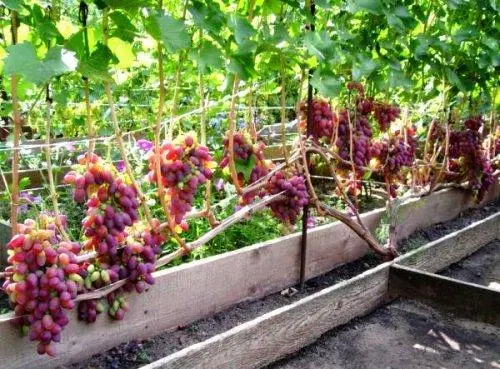
Cuttings of this variety have good rooting, which cannot be said about the survival rate of scions. Therefore, the propagation of the variety by grafting is rather difficult, while the cultivation of own-rooted seedlings does not present any particular problems.
Berries after ripening should not be overexposed on the bushes, they can quickly lose their presentation. It is better to harvest the crop as soon as the clusters ripen. Moreover, wasps also adore this grape variety and are not averse to eating it whole.
What else Rizamat grapes are famous for is their amazing yield. On average, 200-250 centners of berries are harvested from one hectare of plantings. But this says little to an ordinary summer resident, but if you say that 70-80 kg of grapes can be harvested from one bush, then this fact is already able to impress anyone.
But unfortunately, the list of advantages of the variety ends there. And you can move on to its shortcomings. Rizamat grapes do not tolerate frosts below -18 ° C, which means that they need very good shelters even in the south of Our Country. A few layers of polyethylene and burlap will not be enough for him. Most likely, you will need to cover the vines with earth, which, of course, is very laborious.
In addition, Rizamat is resistant to diseases and, above all, to oidium, or in other words, to powdery mildew. According to various sources, he needs from 3-4 to 5-7 treatments against diseases per season. True, in the modern world this has become easier than in the past.

Well, in order to get a plentiful and high-quality harvest, grapes need regular watering and top dressing, in addition, he is one of the adherents of a high agricultural background. This means that before planting grape bushes, the soil should not only be freed from weeds as much as possible, but also comprehensively fertilized and groomed.
Characteristics of grapes and berries
Rizamat can rightly be proud of both the appearance of its berries and bunches, and their taste.
- Clusters have a non-strict conical shape with branches of various sizes.
- Their size is usually large and very large. The weight of an average bunch is 700-900 grams, but brushes weighing two or even three kilograms are often found.
- The clusters are not very dense, they can be called rather loose. In the video below, you can take a closer look at the bunches of a young Rizamat grape bush.
- The berries are also large in size, their weight can reach up to 14-15 grams.
- The shape of the berries is oblong, cylindrical. In length, they can reach 4-5 cm. Although sometimes the berries are of the usual oval shape. The most interesting thing is that Rizamat has berries of slightly different shapes on the same bush.
- The skin is thin, the taste is completely imperceptible, of a pink hue, and on the one hand the berries are darker and more saturated than on the other.

- The berries are covered with a wax coating of medium density.
- The flesh of the Rhizomata grapes is very dense and crispy.
- There are few seeds, about 3-4 per berry, and they are almost invisible when eating. It is for this reason that raisins, absolutely amazing in taste and beauty, can be made from Rizamat berries.
- The taste is sweet, juicy, absolutely unique. It can reach sugar content from 18 to 23 Brix. At the same time, the acidity level is 5-6 g / l. Tasters give its berries one of the highest ratings – 9,1 points on a 10-point scale.
- The use is universal – Rizamat is a real delicacy when fresh, and, moreover, it produces very beautiful and tasty raisins. Of course, both juices and compotes can be made from it, but it’s even somehow a pity to let such beauty go into processing.
- Berries are well stored and can withstand short transportation.
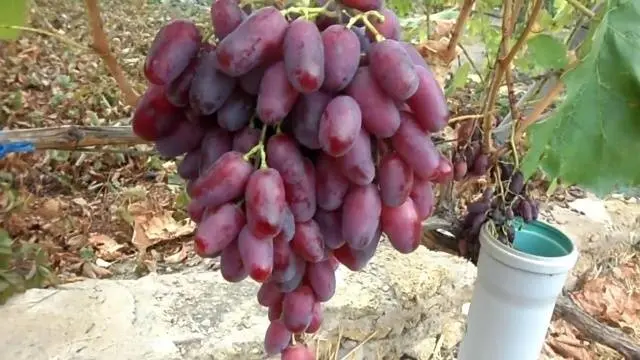
Doubles and “descendants” of Rizamat
Rizamat was and remains such a popular grape variety, despite numerous attempts to discredit it by inept growers, that it has many doubles.
Rizamat Stable
One of the most common doubles of the Ukrainian selection also has many additional names, but genetically it is not related to the real Rizamat at all. This is a completely separate variety, which somewhat resembles Rizamat in the form of clusters and berries, but otherwise has nothing to do with it.

Even judging by the description of the Rizamat grape variety and the reviews on it from the photo, it is difficult to confuse it with real Rizamatam, since its clusters are not so large, the color of the berries is lighter, almost white with a slight pink tint. It ripens much later than the usual Rizamat, and in terms of taste characteristics they are not at all comparable.
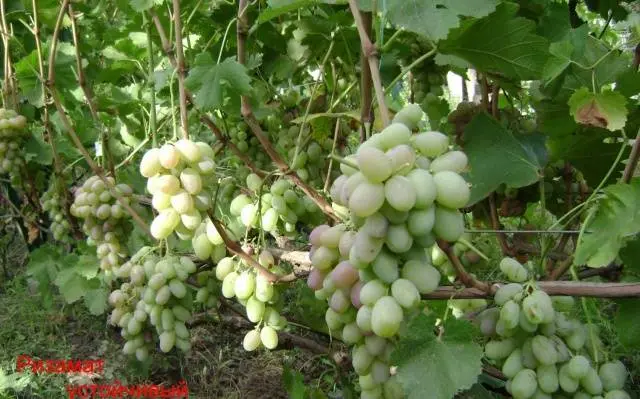
According to the declared characteristics, its disease resistance is higher than that of Rizamat, although judging by the reviews of winegrowers, this indicator is also controversial. Its flowers are female, so they require a pollinator. It is distinguished by a huge growth force, in this respect it is comparable to Rizamat, but still, according to most growers, giving a similar name to this grape is nothing more than a commercial trick.
famous trio
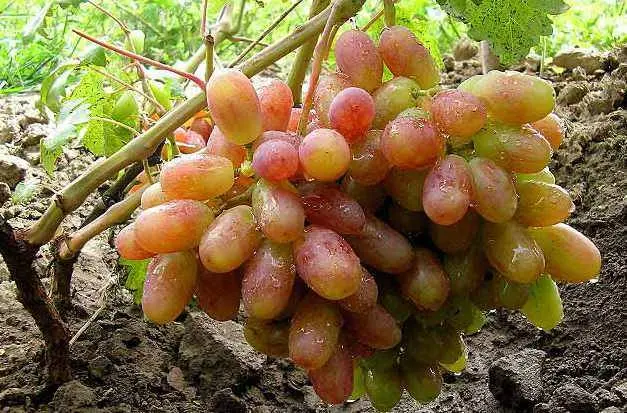
Many believe that the three very popular hybrid forms of Kraynov’s selection: Transfiguration, Anniversary of Novocherkassk and Victor, in many respects, resemble Rizamat grapes. Indeed, bunches and berries are very similar, but at least these forms exist quite independently and do not claim the right, at least to some extent, to be called Rizamat.
Rizamat early

The grape variety Slava Moldavii, which is also called early Rizamat or Iranian Shahine, outwardly quite strongly resembles Rizamat. But his berries are still smaller in weight and size, disease resistance is almost the same, and he can greatly upset the taste.
Descendant of Rizamat
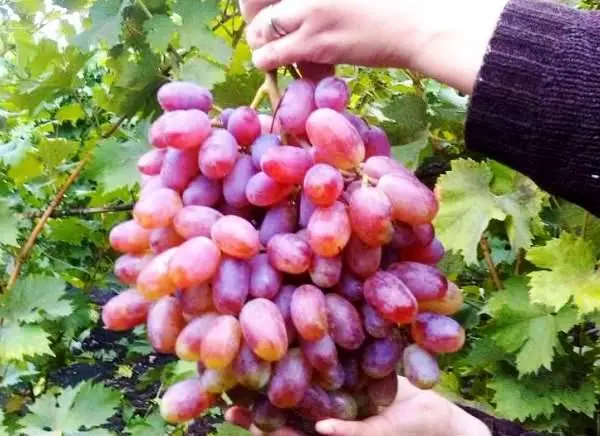
Breeder Kapelyushny bred another interesting hybrid form obtained from crossing Rizamat and Talisman, which he originally called the Descendant of Rizamat. The shape turned out to be quite successful, with berries similar to Rizamat berries, otherwise it requires more detailed study. In recent years, she has been renamed Julian, so as not to inflame passions around Rizamat.
Finally, on the Internet you can also find a variety called Black Rizamat. This already resembles an outright fraud, since there is currently no confirmed data on the existence of such grapes, and its description is fully consistent with the description of the usual Rizamat.
Reviews of gardeners
Those who really grew Rizamat on their plots are very satisfied with their grapes and are not going to part with it, except perhaps due to exceptional life circumstances.
Conclusion
Many of the modern forms and varieties of grapes introduced into the culture for someone still cannot replace one old, but unsurpassed variety in some respects. Such is the Rizamat grape, for someone outdated and unstable, but for true connoisseurs and connoisseurs of taste – a real diamond in the grape collection.










